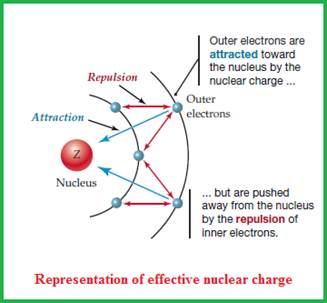
Concept explainers
(a)
Interpretation:
Based on the effective nuclear charge, the strongest and weakest reducing agent has to be identified from the given ions.
Concept Introduction:
Effective nuclear charge:
The overall nuclear charge felt by an electron is known as effective nuclear charge. Because, the attraction between nucleus and the outer shell electron is reduced by the inner shell electrons. This effect is described by saying outer electrons are shielded from the nucleus by the inner electrons.
The value of
Representation of effective nuclear charge:

Figure 1
(b)
Interpretation:
Based on the effective nuclear charge, the strongest and weakest reducing agent has to be identified from the given oxoanions.
Concept Introduction:
Effective nuclear charge:
The overall nuclear charge felt by an electron is known as effective nuclear charge. Because, the attraction between nucleus and the outer shell electron is reduced by the inner shell electrons. This effect is described by saying outer electrons are shielded from the nucleus by the inner electrons.
The value of
Representation of effective nuclear charge:

Figure 1
Want to see the full answer?
Check out a sample textbook solution
Chapter 20 Solutions
General Chemistry: Atoms First
- Platinum(II) forms many complexes, among them those with the following ligands. Give the formula and charge of each complex. (a) two ammonia molecules and one oxalate ion (C2O42-) (b) two ammonia molecules, one thiocyanate ion (SCN-), and one bromide ion (c) one ethylenediamine molecule and two nitrite ionsarrow_forwardGive the number of unpaired electrons in octahedral complexes with strong-field ligands for (a) Rh3+ (b) Mn3+ (c) Ag+ (d) Pt4+ (e) Au3+arrow_forwardThe following reactions all occur in a blast furnace. Which of these are redox reactions? (a) 3Fe2O3(s)+CO(g)2Fe3O4(s)+CO2(g) (b) Fe3O4(s)+CO(g)3FeO(s)+CO2(g) (c) FeO(s)+CO(g)Fe(l)+CO2(g) (d) C(s)+O2(g)CO2(g) (e) C(s)+CO2(g)2CO(g) (f) CaCO3(s)CaO(s)+CO2(g) (g) CaO(s)+SiO2(s)CaSiO3(l)arrow_forward
- Four different octahedral chromium coordination compounds exist that all have the same oxidation state for chromium and have H2O and Cl as the ligands and counterions. When 1 mole of each of the four compounds is dissolved in water, how many moles of silver chloride will precipitate upon addition of excess AgNO3?arrow_forwardAssign oxidation states to the transition-metal ions in the following compounds: TiO2, ZrCl4, VCl3, CrF6, Mo2S3, FeO, AuCl3. Explain, where appropriate, which ligands stabilize the higher oxidation states and why.arrow_forward
 Chemistry: The Molecular ScienceChemistryISBN:9781285199047Author:John W. Moore, Conrad L. StanitskiPublisher:Cengage Learning
Chemistry: The Molecular ScienceChemistryISBN:9781285199047Author:John W. Moore, Conrad L. StanitskiPublisher:Cengage Learning Chemistry: Principles and ReactionsChemistryISBN:9781305079373Author:William L. Masterton, Cecile N. HurleyPublisher:Cengage Learning
Chemistry: Principles and ReactionsChemistryISBN:9781305079373Author:William L. Masterton, Cecile N. HurleyPublisher:Cengage Learning Chemistry: An Atoms First ApproachChemistryISBN:9781305079243Author:Steven S. Zumdahl, Susan A. ZumdahlPublisher:Cengage Learning
Chemistry: An Atoms First ApproachChemistryISBN:9781305079243Author:Steven S. Zumdahl, Susan A. ZumdahlPublisher:Cengage Learning ChemistryChemistryISBN:9781305957404Author:Steven S. Zumdahl, Susan A. Zumdahl, Donald J. DeCostePublisher:Cengage Learning
ChemistryChemistryISBN:9781305957404Author:Steven S. Zumdahl, Susan A. Zumdahl, Donald J. DeCostePublisher:Cengage Learning
 Principles of Modern ChemistryChemistryISBN:9781305079113Author:David W. Oxtoby, H. Pat Gillis, Laurie J. ButlerPublisher:Cengage Learning
Principles of Modern ChemistryChemistryISBN:9781305079113Author:David W. Oxtoby, H. Pat Gillis, Laurie J. ButlerPublisher:Cengage Learning





